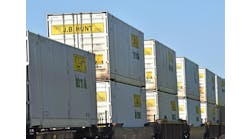If you want an example of the interconnectedness of the supply chain, look no further than the beverage industry. In this segment, one minuscule alteration can have multiple ripple effects on material handling systems. Faced with intense consumer demand for green products and packaging, suppliers of bottled water and carbonated beverages have cranked up the heat on their bottling partners by altering bottle size and structure. The pressure is even greater in cities that have passed legislation banning certain water-bottle sizes in an attempt to reduce environmental waste.
The push to use less material in the bottling industry has created a major trend called lightweighting. As Mike Weaver, president and co-chief executive officer at packaging machinery manufacturer Standard-Knapp, explains, lightweighing occurs when the weight of a typical PET (polyethylene terephthalate) bottle is driven down as far as possible.
“All the water bottles that our machinery works with started out at 18 grams of plastic,” Weaver explains. “Now, they’re down to the 12-gram area. They’re less substantial, but they do have a positive impact on the sustainability front.”
It’s easy to see how a major modification, such as decreasing the average weight of a bottle by onethird, would produce a ripple effect on downstream operations. In virtually all packaging machines—tray packers and loaders, case packers, shrink wrappers and bottle packers—bottles move via conveyor at relatively high speeds. To collect and organize them for packaging, the machine has to slow down, which creates a condition called line pressure.
Though the bottling industry is no stranger to this phenomenon, it’s been exacerbated by lightweight bottles, which are far less tolerant of line pressure. As each bottle pushes against an
adjacent bottle, it becomes pressurized, which can produce one of two results. First, it can damage the shape, which is obviously undesirable for the consumer. Second, and more importantly, the bottles become distorted, making them harder to divide into lanes, handle and meter.
“Think of round bottles that are collected up into a square pattern, like a case of bottled water, four wide by six deep,” Weaver illustrates. “In between each of those bottles would be a starshaped space. That star-shaped space is used to accurately meter the bottles with pins. If the bottles start to compress, the location of that star-shaped space will disappear or will be in the wrong spot.”
One way bottlers are solving this problem is by selecting equipment that can handle lightweight products more effectively. Low-pressure laning systems, such as Standard- Knapp’s Zero-Gap II infeed, can eliminate line pressure at the beginning of a packaging process. Installed between the upstream product conveyor and the original infeed of the machine, this type of machinery distributes product from a nested pattern into multiple lanes. As the lanes fill, product accumulates in the low-pressure area, and electronic population sensors signal the conveyor to increase its speed. Each lane carries product downstream, and then the lanes begin to narrow and line up with the machine’s individual lane guides.
Lightweight containers present additional obstacles. Many polyethylene- type bottles contain diverse products, such as laundry detergent, fruit juice or milk. Those bottles are ordinarily dropped into a corrugated case by a case packer. Sometimes, however, when the bottles land in the case, the liquid creates significant hydraulic pressure. With lightweight bottles, that intense shock can create holes in the bottom, or foot, of the bottle.
Logically, the thickness of the minimum weak spot dictates the weight of the entire bottle. So, because of that one little weak spot, the entire bottle has to be heavier to withstand the shock. In other words, to achieve a stronger weak spot, more material must be used in the whole bottle.
However, there is an alternative. If the bottle can be handled more gently, less material can be used to make the whole bottle. New developments from machinery manufacturers help reduce shock energy to protect thinner-gauge bottles and glass from damage.
| Packaging Resource Many vendors offer specialized equipment to handle delicate product. Find them by visiting the Web site of the Packaging Machinery Manufacturers Institute at www.pmmi.org. |
There are many options for bottlers coping with sustainability requirements. The best advice is to look for packaging machinery that addresses the downstream effects of green.


